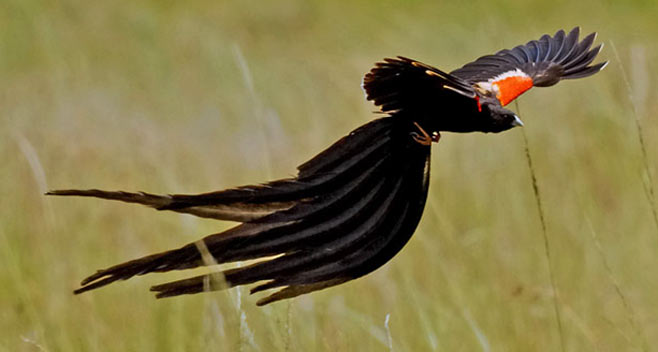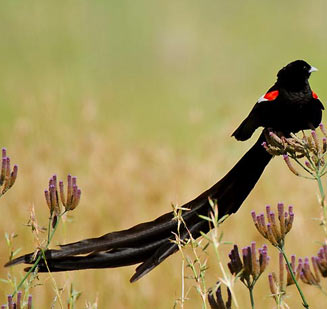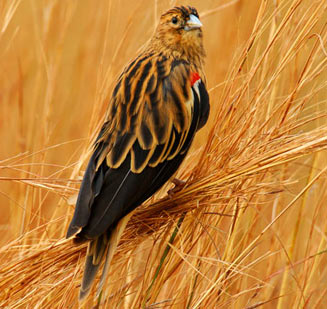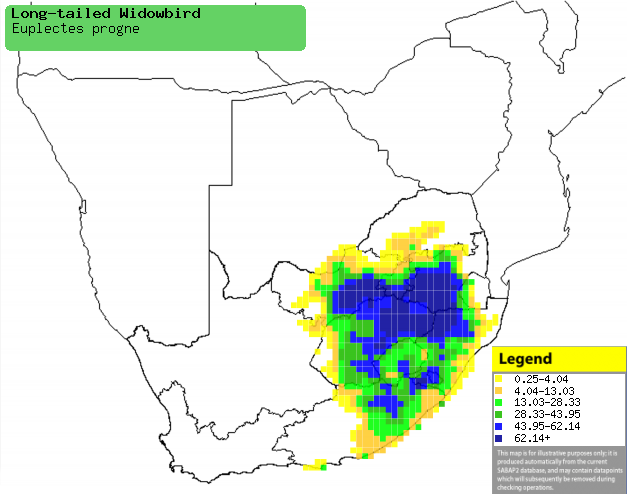|
Euplectes progne
(Long-tailed widowbird, Long-tailed widow)
Langstertflap [Afrikaans];
Ujobela [Xhosa]; iBhaku, iSakabuli [Zulu]; Lehelo, Lepau, Molepe, Tjobolo
[South Sotho]; Lephaka [North Sotho]; Cilori, Ncilakulondza [Tsonga];
Molepê, Molopê [Tswana]; Hanestaartwidavink [Dutch]; Euplecte à longue
queue [French]; Hahnschweifwida [German]; Viúva-rabilonga [Portuguese]
Life
> Eukaryotes >
Opisthokonta
> Metazoa (animals) >
Bilateria >
Deuterostomia > Chordata >
Craniata > Vertebrata (vertebrates) > Gnathostomata (jawed
vertebrates) > Teleostomi (teleost fish) > Osteichthyes (bony fish) > Class:
Sarcopterygii (lobe-finned
fish) > Stegocephalia (terrestrial
vertebrates) > Tetrapoda
(four-legged vertebrates) > Reptiliomorpha > Amniota >
Reptilia (reptiles) >
Romeriida > Diapsida > Archosauromorpha > Archosauria >
Dinosauria
(dinosaurs) > Saurischia > Theropoda (bipedal predatory dinosaurs) >
Coelurosauria > Maniraptora > Aves
(birds) >
Order: Passeriformes > Family: Ploceidae
> Genus: Euplectes
 |
|
Long-tailed widowbird male, South Africa. [photo
Callie de Wet ©] |
 |
 |
|
Long-tailed widowbird male, South Africa. [photo Callie de Wet ©] |
Long-tailed widowbird female, South
Africa. [photo Callie de Wet ©] |
Distribution and habitat
It has three isolated populations; one in Kenya, another
extending from Angola to Zambia and southern DRC and the other in southern
Africa. Here it is locally common in the eastern half of South Africa and in
Lesotho, marginally extending into south-eastern Botswana. It generally prefers
open grassland, breeding in tall grasses along watercourses or in marshy areas,
but it may occur in grassy karoo or savanna at the extremity of its
distribution.
|
 |
|
Distribution of Long-tailed widowbird in southern Africa,
based on statistical smoothing of the records from first SA Bird Atlas
Project (©
Animal Demography unit, University of
Cape Town; smoothing by Birgit Erni and Francesca Little). Colours range
from dark blue (most common) through to yellow (least common).
See here for the latest distribution
from the SABAP2. |
Food
It mainly eats seeds, supplemented with arthropods, doing
most of its foraging in flocks on the ground but occasionally hawking insects
aerially. The following food items have been recorded
in its diet:
- Seeds
- Setaria sphacelata (Twisted-leaf bristle grass)
- Paspalum dilatatum (Common paspalum)
- Paspalum distichum (Couch paspalum)
- Pennisetum clandestinum (Kikuyu grass)
- Triticum (wheat)
- Themeda triandra (Rooigras)
- Senecio juniperinus (groundsel)
- Arthropods
Breeding
- Polygynous, solitary nester, as a single males may mate with up to about 5
females in one breeding season.
- The nest can be built by either the male or female, consisting of a
thick-walled, vertical-oriented oval structure with a side-top entrance,
made of woven fine grass and lined by the female with flowering grass heads.
It is typically placed low down in a tuft of grass, the leaves of which are
incorporated into the nest, usually just above damp ground or shallow water.
- Egg-laying season is from October-June, peaking from November-February.
- It lays 1-4 eggs at one day intervals, which are incubated solely by the
female for about 12-14 days.
- The chicks are fed and brooded by the female only, leaving the nest
after about 17 days to hide in the grass since they cannot fly strongly,
remaining dependent on their mother for food for about 2 weeks more.
Threats
Not threatened, although it mainly occurs in grassland on
private land which is vulnerable to overgrazing, too frequent fires, human
settlement and commercial afforestation.
References
-
Hockey PAR, Dean WRJ and Ryan PG 2005. Roberts
- Birds of southern Africa, VIIth ed. The Trustees of the John Voelcker
Bird Book Fund, Cape Town.
|
